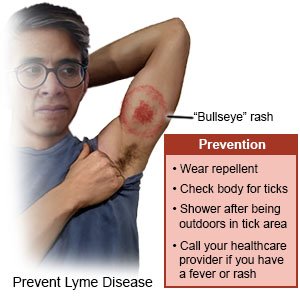Lyme Disease
Medically reviewed by Drugs.com. Last updated on Sep 23, 2025.
What is Lyme disease?
Lyme disease is a bacterial infection caused by the bite of an infected tick.
What increases your risk for Lyme disease?
- You work in a wooded area or area with heavy brush
- You travel to or live in areas where ticks are common
- You walk, hike, hunt, camp, or fish in a grassy or wooded area
What are the signs and symptoms of Lyme disease?
- A red rash that is often round and may look like a target or bull's eye
- Fever, chills, or sore throat
- Weakness and tiredness
- Headache or muscle aches
- Joint pain
- Abdominal pain, nausea, or diarrhea
How is Lyme disease diagnosed?
Your healthcare provider will examine you and ask about your symptoms. Tell him or her if you live or work in a grassy or wooded area or have been active outside in these areas. You may need any of the following:
- Blood tests may show the bacteria that cause Lyme disease.
- A sample of joint fluid may be tested for the bacteria that cause Lyme disease.
How is Lyme disease treated?
Antibiotics treat the bacteria infection.
Treatment options
The following list of medications are related to or used in the treatment of this condition.
How can I prevent a tick bite?
Ticks live in areas covered by brush and grass. They may even be found in your lawn if you live in certain areas. Outdoor pets can carry ticks inside the house. Ticks can grab onto you or your clothes when you walk by grass or brush. If you go into areas that contain many trees, tall grasses, and underbrush, do the following:
 |
- Wear light colored pants and a long-sleeved shirt. Tuck your pants into your socks or boots. Tuck in your shirt. Wear sleeves that fit close to the skin at your wrists and neck. This will help prevent ticks from crawling through gaps in your clothing and onto your skin. Wear a hat in areas with trees.
- Apply insect repellant on your skin. The insect repellant should contain DEET. Do not put insect repellant on skin that is cut, scratched, or irritated. Always use soap and water to wash the insect repellant off as soon as possible once you are indoors. Do not apply insect repellant on your child's face or hands.
- Spray insect repellant onto your clothes. Use permethrin spray. This spray kills ticks that crawl on your clothing. Be sure to spray the tops of your boots, bottom of pant legs, and sleeve cuffs. As soon as possible, wash and dry clothing in hot water and high heat.
- Check your and your child's clothing, hair, and skin for ticks. Shower within 2 hours of coming indoors. Carefully check the hairline, armpits, neck, and waist.
- Decrease the risk for ticks in your yard. Ticks like to live in shady, moist areas. Mow your lawn regularly to keep the grass short. Trim the grass around birdbaths and fences. Cut branches that are overgrown and take them out of the yard. Clear out leaf piles. Stack firewood in a dry, sunny area.
- Treat pets with tick control products as directed. This will decrease your risk for a tick bite. Check your pets for ticks. Remove ticks from pets the same way as you remove them from people. Ask your pet's veterinarian about the best product to use on your pet.
- Remove a tick with tweezers. Wear gloves. Grasp the tick as close to your skin as possible. Pull the tick straight up and out. Do not touch the tick with your bare hands. Check to make sure you removed the whole tick, including the head. Clean the area with soap and water or rubbing alcohol. Then wash your hands with soap and water.

Call your local emergency number (911 in the US) if:
- Your heart is beating faster than usual and you feel dizzy.
- You have chest pain or trouble breathing.
- You suddenly cannot talk or see well, or you have trouble moving an area of your body.
When should I seek immediate care?
- You have a headache and a stiff neck.
- You have trouble concentrating or thinking clearly.
- You have numbness or tingling in your arms or legs, or you have trouble walking.
When should I call my doctor?
- Your rash grows or spreads to other areas of your body.
- You suddenly have trouble falling or staying asleep.
- You have new or worsening pain and swelling in your joints.
- You have new or worsening weakness and muscle pain.
- You have a new tick bite.
- You have questions or concerns about your condition or care.
Care Agreement
You have the right to help plan your care. Learn about your health condition and how it may be treated. Discuss treatment options with your healthcare providers to decide what care you want to receive. You always have the right to refuse treatment. The above information is an educational aid only. It is not intended as medical advice for individual conditions or treatments. Talk to your doctor, nurse or pharmacist before following any medical regimen to see if it is safe and effective for you.© Copyright Merative 2025 Information is for End User's use only and may not be sold, redistributed or otherwise used for commercial purposes.
Learn more about Lyme Disease
Treatment options
Symptoms and treatments
Further information
Always consult your healthcare provider to ensure the information displayed on this page applies to your personal circumstances.
